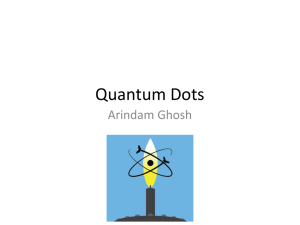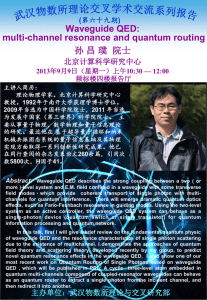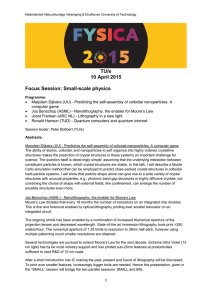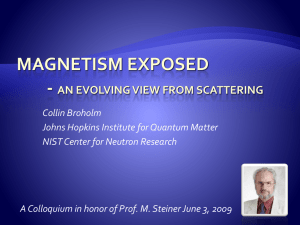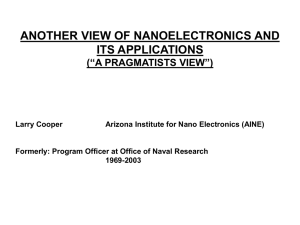Weak measurement of cotunneling time
advertisement
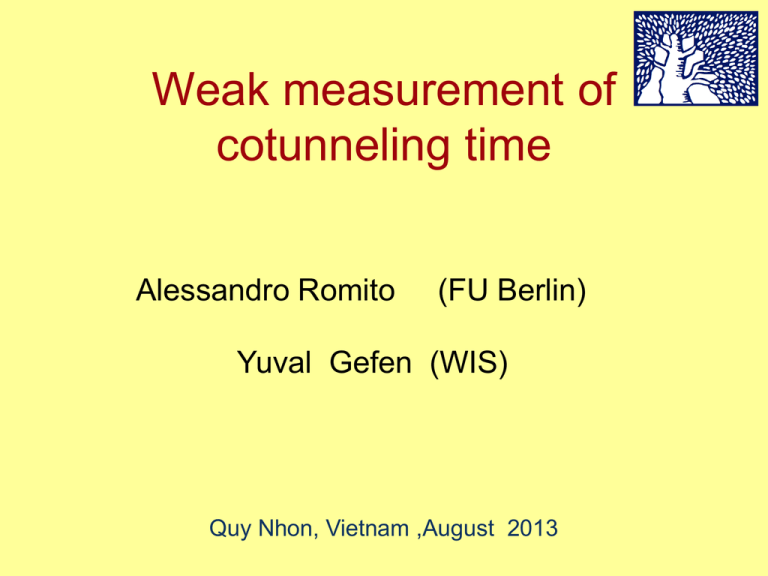
Weak measurement of
cotunneling time
Alessandro Romito
(FU Berlin)
Yuval Gefen (WIS)
Quy Nhon, Vietnam ,August 2013
Weak values – introduction for pedestrians
WV good to observe virtual states
Weak measurement of cotunneling time
quantum dot
I
QPC=Quantum Point Contact
WEAK MEASUREMENT =
WEAK SYSTEM/DETECTOR ENTANGLEMENT
Weak
measurements
FQMC13
weak measurement weak value:
Aharonov, Albert, Vaidman 1988
time
post selection
(eigenvalue of Aˆ )
[ Aˆ , Bˆ ] 0
weak measuremet
of Bˆ
preparation
in
preselected state
post-selected state
0
fin
Bˆ weakly measured observable
Bˆ
weak
0
fin
| Bˆ | in
0
fin
| in
can be complex !
Weak
measurements
projective measurement
weak measurement
[Von Neumann (1932)]
FQMC13
Postselection and
WV
FQMC13
weak value
weak
time
[Y. Aharonov et al. (1988)]
What for?
CQOX - QIM
Foundations of quantum mechanics:
counterfactual statements
measurement of simultaneous observables
access new observables
measure wave function
Experimental verification
violation of classical inequalities
quantum optics
...
solid state (2013!)
Precision
measurements
quantum spin Hall effect of light
spacial displacements
charge sensing
...
Application
quantum feedback control
state discrimination
WHAT ARE WEAK VALUES GOOD FOR?
Foundations of Quantum Mechanics
counterfactual correlations
simultaneous measurement of non-commuting observables
access to new observables
measure wave function
Bell-type inequalities
Precision Measurement / Amplification
small spatial displacements
charge sensing
Quantum spin-Hall effect of light
Applications
quantum feedback control
quantum state discrimination
Realizations
optics
Josephson junction / optical cavity
solid state?
accessing a quantum virtual state
accessing a MANY-BODY quantum virtual state
Cotunneling
[D. Averin, Yu. V. Nazarov (1990)]
Cotunneling
Can you detect the extra charge in the dot?
For how long there is an extra charge in the dot in a
successful cotunneling event?
Charging
energy
Thouless
energy
Level
spacing
[D. Averin, Yu. V. Nazarov (1990)]
How to detect?
Simpler case:
sequential
tunneling
strong
measurement
Classical
probabilities
Experimentally
available
Sukhorukov, Ihn, Ensslin et al. (2007)]
sequential
tunneling
Simpler case:
(1)
seq
lim
T
T
t
0
0
(0)
dt
ds
P
(
s
)[
J
(
t
s
)
J
] I (t )
weak measurement
current-current
correlations
(self-consistent)
T I ( J (1) J (0) )
quantum correlations
cotunneling
microscopic
model
weak measurement
N N 1
system
change in transmission of QPC:
detector
Amplitude Amplitude ( iu )
Tunneling time
FQMC13
long-lasting question
Mac Coll (1932), Condon (1933), Wigner (1955) [delay time]..., Smith (1960) [dwell
time],,,, Baz’ (1966) [Larmor precession]..., Buttiker & Landauer (1982) [time dep.
modulation], Sokolovski & Connor (1993) [path integral], Steinberg (1995) [weak
values]....
E / EC
Cotunneling time
<I>, elastic
SIJ, elastic
x 64
FQMC13
Re{ WV } dwell
inelastic
Im{ WV } cot
0
/ EC
0
1
/ EC
2
elastic
ETh EC
L2 ETh
ETh EC
| X S X D |2
0
2d
L2 ETh
ETh
EC
2
| XS XD |
0
2
L
ETh
3
1
ln (
)
2
2 EC
| X S X D | EC
/ EC
2d
NOTE:
cot / EC
Summary
FQMC13
ga eneralizing the measurement scheme of
sequential tunneling
,
the
cotunneling time can be defined via weak
a
values
,
The
3e cotunneling time may deviate from the
prediction of the uncertainty principle





